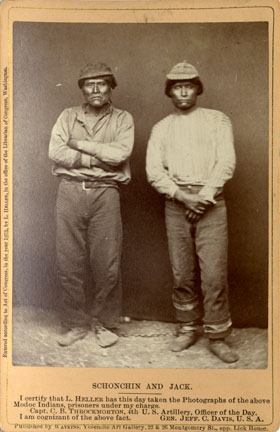Native History: Rigged Trial Sentences Modoc Leader Captain Jack to Death
This Date in Native History: On October 3, 1873, the U.S. military hanged four Modoc Indians who were found guilty of murdering General Edward Canby during the Modoc War in Oregon.
Canby, a Civil War hero, was the only general and the highest ranking military official ever killed by Indians. The Modoc also killed a minister during the April 11, 1873 incident near the end of a six-month war set against the rugged terrain of northern California’s lava beds.
The war, which started in November 1872, pitted the small Modoc Tribe—numbering fewer than 400 people—against the United States Army. Led by Captain Jack and Schonchin John, the Modoc fought to retain rights to their homeland, a six-square-mile reservation.
“The war really was about greed,” said Taylor Tupper, spokeswoman for the Klamath Tribes. “It’s not a secret that the federal government and certain individuals wanted the land for themselves. This was happening across the nation. The land was going to be taken, tribes were supposed to disappear, to no longer exist.”
The military forcibly moved the Modoc from their reservation and sent them to live on the neighboring Klamath reservation.
“There’s been a lot of speculation about the relationships there,” Tupper said. “History books have deemed the Klamath and Modoc mortal enemies, but that really wasn’t the case. Mostly the Klamath stayed on their lands and the Modoc stayed on their lands. When they were forced to live together on Klamath land, that’s when the conflict started.”
The Modoc resisted relocation and war eventually broke out, but the odds were against them from the start, said Cheewa James, author of the 2008 book, Modoc: The Tribe that Wouldn’t Die.
Although 150 Modoc participated in the resistance, only 55 were warriors. The rest were women and children. By the end of the war, the Army’s force had grown to 1,000 men. The Modoc were outnumbered 20 to one.
Captain Jack led his people to a stronghold among the lava beds, where they held off U.S. forces for nearly six months.
“The Modoc did well because they knew the land,” James said. “They were holed up in a natural lava fortress the Army couldn’t penetrate.”
Then a group of six Modoc men carried concealed weapons to a peace commission, where Captain Jack shot and killed the unarmed general. Another Modoc man shot and killed the Rev. E. Thomas.
Newspapers across the country reported the killings, calling the Modoc “wild beasts” and the incident the “most dastardly assassination yet known in either ancient or modern history.” Two Chicago newspapers demanded extermination of the Modoc.
Very few newspapers, if any, reported that Army commissioners who attended the meeting with Canby also violated war laws by concealing weapons, James said.
Captain Jack and his followers were captured by June. Six men stood trial and were convicted of war crimes—the only time the United States tried American Indians for violating the laws of war. Captain Jack, Schonchin John and two others were sentenced to death. Two additional men were sentenced to life in prison at Alcatraz.
If the trial were held today, “it would be so illegal, so ridiculous, that it would almost be laughable,” James said. “The jury was made up of military officers. There were men on the jury that had actually been in battle against the accused. The Modoc had no legal counsel and a portion of them didn’t speak English.”
More than 2,000 people attended the public hangings, James said. School even dismissed early so children could attend with their parents.
“All the Modoc people, every remaining tribal member was forced to watch, including the four men’s families,” she said. “Imagine the scaffold and four men up there. Imagine all those people standing around.”
The execution occurred at 10:10 a.m. A man raised a white handkerchief then lowered it, signaling the executioner to pull the rope.
“A roar went up from the crowd,” James said. “When Modoc mourn, they wail, they cry, for long periods of time. That was the sound at the hangings.”
After the execution, the rest of the Modoc resisters were rounded up, put on a train and relocated to Oklahoma, James said. Some of the women wailed the whole way.
Read more at http://indiancountrytodaymedianetwork.com/2013/10/03/native-history-unfair-trial-results-hanging-four-modoc-indians-151557


